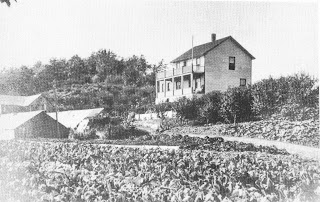 |
| Reeves Family Home, Humber Bay, ON |
| Humber Bay Cenotaph, R.C.L. 8th Street |
 |
| Humber Bay Market Gardens, circa 1935 |
 |
| Sapper Thomas Reeves |
Duisans - Arras, France
B Company double tracking Duisans to Achicourt. The attached labour, 12th West Riding, 550 strong, has now changed into the 24th and 5th Labour Companies, the total average attached labour on the work, including 450 2nd Canadian Labour Battalion mounts to 990 attached labour altogether. C Company ballasting Arras-Pampoux Line north of Scarpe River, also grading into Pampoux. 2 other ranks killed and one wounded of the 5th Bn., C.R.T., 4 other ranks killed and 7 wounded of 12th Lincolns attached. Damage to line, 1 break, repaired at once. 2 platoons worked till 2:00 am 15-517 unloading train at Q Dump. General maintenance carried on. D Company, 1 platoon grading on "B7" Line, 1 platoon on "B6" Line, 2 platoons on maintenance of "D" and "D2" Lines. 180 attached labour divided between "B6" and "B7" Lines. Weather - fine.
And so a brutal day for the "C" Company, 5th battalion, CRT and young Sapper Thomas Reeves and his brother in arms, Sapper Jacob Orr Cherry #27524, were initially interred in the closer burial ground, Rue St. Michel British Cemetery, Arras. However with battlefield consolidations, the bodies were exhumed in 1921 and reburied int he larger Faubourg-D'Amiens Cemetery, Arras, where they lay to this day.
 I have yet to receive the World War One service records of Thomas' two older brothers, Cedric and Frank, however they have been ordered. The Reeves family have remained active in the florist/garden business in Toronto since the turn of the century. The area of family market gardens located in the Humber Bay/Stonegate area of Etobicoke, north of the Queensway and south of Bloor street, west of the Humber River, is now asphalt and concrete. By count there are approximately 75 low-rise apartment buildings in the neighbourhood. Plans have been announced to redevelop the plaza into a high-rise community with food stores, library and storefront community centre. Park Lawn Cemetery remains as tranquil as ever and home to Francis Frederick Reeves and wife, Catherine (as well as our Richardson, Timpson and Clearwater Families).
I have yet to receive the World War One service records of Thomas' two older brothers, Cedric and Frank, however they have been ordered. The Reeves family have remained active in the florist/garden business in Toronto since the turn of the century. The area of family market gardens located in the Humber Bay/Stonegate area of Etobicoke, north of the Queensway and south of Bloor street, west of the Humber River, is now asphalt and concrete. By count there are approximately 75 low-rise apartment buildings in the neighbourhood. Plans have been announced to redevelop the plaza into a high-rise community with food stores, library and storefront community centre. Park Lawn Cemetery remains as tranquil as ever and home to Francis Frederick Reeves and wife, Catherine (as well as our Richardson, Timpson and Clearwater Families).Special thanks are extended to Michael Harrison, Denise Harris from the Etobicoke Historical Society and Jessica Ehrenworth of Toronto Archives, without whom their cooperation, this blog would not be possible.
Illustrations and photographs: special thanks to Marika Pirie and book "Memories of a Place Called Humber Bay", Harry & Blanche Hall, 1991
Thanks as well to David Bluestein, new owner of the medals, for the Telegram newspaper clippings.







